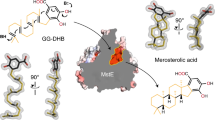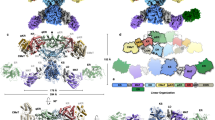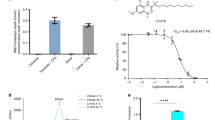Abstract
In higher organisms the formation of the steroid scaffold is catalysed exclusively by the membrane-bound oxidosqualene cyclase (OSC; lanosterol synthase). In a highly selective cyclization reaction OSC forms lanosterol with seven chiral centres starting from the linear substrate 2,3-oxidosqualene. Valuable data on the mechanism of the complex cyclization cascade have been collected during the past 50 years using suicide inhibitors, mutagenesis studies and homology modelling. Nevertheless it is still not fully understood how the enzyme catalyses the reaction1,2. Because of the decisive role of OSC in cholesterol biosynthesis it represents a target for the discovery of novel anticholesteraemic drugs that could complement the widely used statins3. Here we present two crystal structures of the human membrane protein OSC: the target protein with an inhibitor that showed cholesterol lowering in vivo opens the way for the structure-based design of new OSC inhibitors. The complex with the reaction product lanosterol gives a clear picture of the way in which the enzyme achieves product specificity in this highly exothermic cyclization reaction.
This is a preview of subscription content, access via your institution
Access options
Subscribe to this journal
Receive 51 print issues and online access
$199.00 per year
only $3.90 per issue
Buy this article
- Purchase on Springer Link
- Instant access to full article PDF
Prices may be subject to local taxes which are calculated during checkout




Similar content being viewed by others
References
Wendt, K. U., Schulz, G. E., Corey, E. J. & Liu, D. R. Enzyme mechanisms for polycyclic triterpene formation. Angew. Chem. Int. Edn Engl. 39, 2812–2833 (2000)
Hoshino, T. & Sato, T. Squalene-hopene cyclase: catalytic mechanism and substrate recognition. Chem. Commun. (Camb.) 4, 291–301 (2002)
Morand, O. H. et al. Ro 48–8071, a new 2,3-oxidosqualene:lanosterol cyclase inhibitor lowering plasma cholesterol in hamsters, squirrel monkeys, and minipigs: comparison to simvastatin. J. Lipid Res. 38, 373–390 (1997)
Wendt, K. U., Poralla, K. & Schulz, G. E. Structure and function of a squalene cyclase. Science 277, 1811–1815 (1997)
Poralla, K. et al. A specific amino acid repeat in squalene and oxidosqualene cyclases. Trends Biochem. Sci. 19, 157–158 (1994)
Ruf, A. et al. The monotopic membrane protein human oxidosqualene cyclase is active as monomer. Biochem. Biophys. Res. Commun. 315, 247–254 (2004)
Blobel, G. Intracellular protein topogenesis. Proc. Natl Acad. Sci. USA 77, 1496–1500 (1980)
Milla, P. et al. Thiol-modifying inhibitors for understanding squalene cyclase function. Eur. J. Biochem. 269, 2108–2116 (2002)
Loll, P. J., Picot, D. & Garavito, R. M. The structural basis of aspirin activity inferred from the crystal structure of inactivated prostaglandin H2 synthase. Nature Struct. Biol. 2, 637–643 (1995)
Wendt, K. U., Lenhart, A. & Schulz, G. E. The structure of the membrane protein squalene-hopene cyclase at 2.0 Å resolution. J. Mol. Biol. 286, 175–187 (1999)
Corey, E. J., Matsuda, S. P. T., Baker, C. H., Ting, A. Y. & Cheng, H. Molecular cloning of a Schizosaccharomyces pombe cDNA encoding lanosterol synthase and investigation of conserved tryptophan residues. Biochem. Biophys. Res. Commun. 219, 327–331 (1996)
Zoltewicz, J. A., Maier, N. M. & Fabian, W. M. F. π–cation and π–dipole-stabilizing interactions in a simple model system with cofacial aromatic rings. J. Org. Chem. 63, 4985–4990 (1998)
Miklis, P. C., Ditchfield, R. & Spencer, T. A. Carbocation–π interaction: computational study of complexation of methyl cation with benzene and comparisons with related systems. J. Am. Chem. Soc. 120, 10482–10489 (1998)
Gallivan, J. P. & Dougherty, D. A. Cation–π interactions in structural biology. Proc. Natl Acad. Sci. USA 96, 9459–9464 (1999)
Schulz-Gasch, T. & Stahl, M. Mechanistic insights into oxidosqualene cyclizations through homology modeling. J. Comput. Chem. 24, 741–753 (2003)
Reinert, D. J., Balliano, G. & Schulz, G. E. Conversion of squalene to the pentacarbocyclic hopene. Chem. Biol. 11, 121–126 (2004)
Corey, E. J. et al. Methodology for the preparation of pure recombinant S. cerevisiae lanosterol synthase using a baculovirus expression system. Evidence that oxirane cleavage and A-ring formation are concerted in the biosynthesis of lanosterol from 2,3-oxidosqualene. J. Am. Chem. Soc. 119, 1277–1288 (1997)
Gandour, R. D. On the importance of orientation in general base catalysis by carboylate. Bioorg. Chem. 10, 169–176 (1981)
Corey, E. J. et al. Studies on the substrate binding segments and catalytic action of lanosterol synthase. Affinity labeling with carbocations derived from mechanism-based analogs of 2,3-oxidosqualene and site-directed mutagenesis probes. J. Am. Chem. Soc. 119, 1289–1290 (1997)
Abe, I., Zheng, Y. F. & Prestwich, G. D. Photoaffinity labeling of oxidosqualene cyclase and squalene cyclase by a benzophenone-containing inhibitor. Biochemistry 37, 5779–5784 (1998)
Brown, G. R. et al. Quinuclidine inhibitors of 2,3-oxidosqualene cyclase–lanosterol synthase: optimization from lipid profiles. J. Med. Chem. 42, 1306–1311 (1999)
Dehmlow, H. et al. Synthesis and structure–activity studies of novel orally active non-terpenoic 2,3-oxidosqualene cyclase inhibitors. J. Med. Chem. 46, 3354–3370 (2003)
Jolidon, S., Polak-Wyss, A., Hartmann, P. G. & Guerry, P. in Recent Advances in the Chemistry of Anti-infective Agents (ed. Bentley, P. H.) 223–233 (Royal Soc. Chemistry, Cambridge, 1993)
Lenhart, A., Weihofen, W. A., Pleschke, A. E. & Schulz, G. E. Crystal structure of a squalene cyclase in complex with the potential anticholesteremic drug Ro48–8071. Chem. Biol. 9, 639–645 (2002)
Otwinowski, Z. & Minor, W. M. Processing of X-ray diffraction data collected in oscillation mode. Methods Enzymol. 276, 307–326 (1997)
Vagin, A. & Teplyakov, A. MOLREP: an automated program for molecular replacement. J. Appl. Crystallogr. 30, 1022–1025 (1997)
Morris, R. J., Perrakis, A. & Lamzin, V. S. ARP/wARP's model-building algorithms. I. The main chain. Acta Crystallogr. D 58, 968–975 (2002)
Gerber, P. R. Peptide mechanics: a force field for peptides and proteins working with entire residues as small units. Biopolymers 32, 1003–1017 (1992)
Murshudov, G. N., Vagin, A. A., Lebedev, A., Wilson, K. S. & Dodson, E. J. Efficient anisotropic refinement of macromolecular structures using FFT. Acta Crystallogr. D 55, 247–255 (1999)
Roversi, P., Blanc, E., Vonrhein, C., Evans, G. & Bricogne, G. Modelling prior distributions of atoms for macromolecular refinement and completion. Acta Crystallogr. D 56, 1316–1323 (2000)
Acknowledgements
We thank the staff at the beamline X06SA at the Swiss Light Source (SLS, Switzerland) for support, and C. Vonrhein (Global Phasing Ltd) for an early version of autoBUSTER. We thank all colleagues at Roche Basel for support, and especially O. Morand for discussions.
Author information
Authors and Affiliations
Corresponding author
Ethics declarations
Competing interests
The authors declare that they have no competing financial interests.
Supplementary information
Supplementary Table 1
Data collection and refinement statistics. (DOC 2642 kb)
Rights and permissions
About this article
Cite this article
Thoma, R., Schulz-Gasch, T., D'Arcy, B. et al. Insight into steroid scaffold formation from the structure of human oxidosqualene cyclase. Nature 432, 118–122 (2004). https://doi.org/10.1038/nature02993
Received:
Accepted:
Issue Date:
DOI: https://doi.org/10.1038/nature02993
This article is cited by
-
Current advances in the biotechnological synthesis of betulinic acid: new findings and practical applications
Systems Microbiology and Biomanufacturing (2023)
-
Combination treatment of docetaxel with caffeic acid phenethyl ester suppresses the survival and the proliferation of docetaxel-resistant prostate cancer cells via induction of apoptosis and metabolism interference
Journal of Biomedical Science (2022)
-
Biosynthesis of saponin defensive compounds in sea cucumbers
Nature Chemical Biology (2022)
-
The estrogen receptor beta agonist liquiritigenin enhances the inhibitory effects of the cholesterol biosynthesis inhibitor RO 48-8071 on hormone-dependent breast-cancer growth
Breast Cancer Research and Treatment (2022)
-
Reaction mechanism of the farnesyl pyrophosphate C-methyltransferase towards the biosynthesis of pre-sodorifen pyrophosphate by Serratia plymuthica 4Rx13
Scientific Reports (2021)
Comments
By submitting a comment you agree to abide by our Terms and Community Guidelines. If you find something abusive or that does not comply with our terms or guidelines please flag it as inappropriate.



